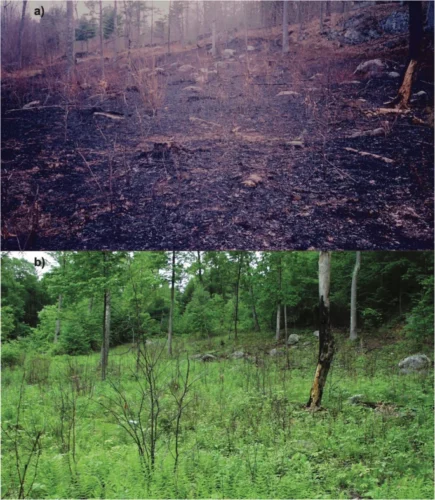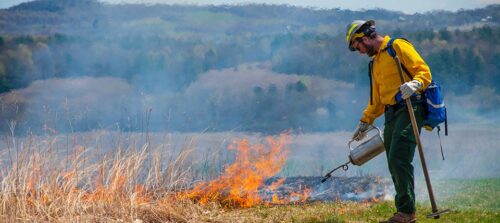A prescribed burn. Image courtesy of National Park Services
For the past hundred years, human interventions—including fire-suppression policies—essentially removed fire as an ecological factor from New England forests. The lack of fires has drastically altered the landscape of these forests. Past studies have shown the short-term implications of the removal of regular disturbances such as low-intensity fires, but a recent publication by researchers at the Yale School of the Environment characterized the long-term effects of reintroducing prescribed burns on southern New England oak-hickory forests. “By reintroducing fire, we were trying to return the forest to its natural state,” said Caroline Borden, first author of the study.
Implementing a cutting and burning treatment, the researchers conducted a before-after-control impact study to collect data on control plots that were never burned and treatment plots that were burned on several occasions over a twenty-three-year period. After removing the midstory (middle layer trees) and some of the overstory (upper layer trees) by cutting, they collected data on the remaining overstory and understory (ground level plants) before and after the burn treatments. They also collected soil samples after multiple burn treatments.
Comparing the control and treatment plots, the researchers showed that prescribed burning, which mimics the low-intensity fires that were likely observed over large areas of southern New England during pre-European settlement, resulted in greater understory plant density and diversity, driving compositional shifts towards more shade-intolerant plants. Furthermore, there was a higher level of variance in soil nutrients like nitrogen and potassium on burned plots, which may be a potential driver of increased understory diversity. Together, these results show the potential of a cut and burn treatment. “The combination cutting and burning treatment appears to be successful at driving compositional shifts and maintaining high understory diversity,” Borden said.
The suppression of fires over the last 100 years has played a role in recent catastrophic wildfires on the West Coast. “With the suppression of fire, the forests have become way overstocked in carrying capacity, and with the onset of recent droughts—more severe because of shifts in climate—trees have become stressed, predisposed to insects and disease, and subsequently many of the stems are now standing dead,” said Mark Ashton, principal investigator of the study. “One dry lightning strike or human match and the whole lot goes off.”

Borden hopes this research will help guide future implementation of prescribed burns. “My biggest goal for this publication is that it falls into the hands of other researchers and foresters working in similar oak-hickory systems so that it can inform their use of prescribed burns in the future.” Borden said. “This was one reason that we chose to publish it in Fire Ecology, an open-access journal.”
Studying this site has been extremely rewarding for Borden. “As a student researcher, one of the most exciting aspects of this project was being able to situate our observations in the broader historical context of this ecosystem,” Borden said. Members of the Ashton Lab just implemented another prescribed burn in the spring of 2020, and Borden hopes that future researchers will continue to study this site.

